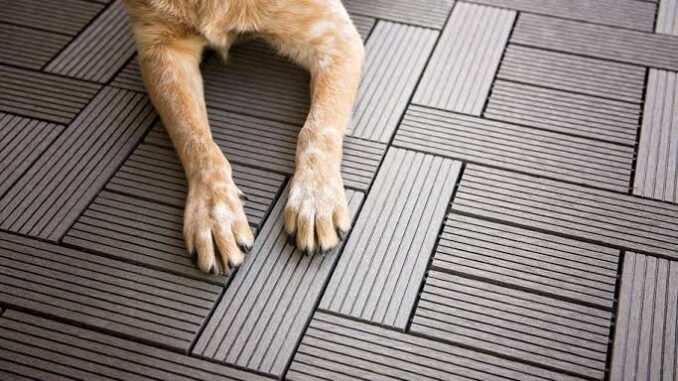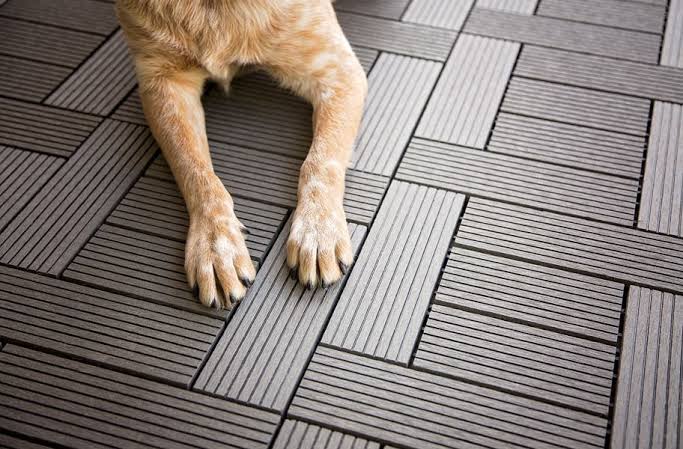
Top Pet-Friendly Flooring Options for Homes: When it comes to creating a home that’s welcoming for both humans and pets, flooring plays a critical role. From muddy paws and sharp claws to occasional accidents and spills, the floors in pet-friendly homes need to be tough, low-maintenance, and safe for furry friends.

Choosing the right flooring can help prevent damage, reduce cleaning time, and improve the comfort and safety of your pets. In this guide, we’ll dive into the best flooring options for pet owners, what to look for in pet-friendly flooring, and how to weigh aesthetics, durability, and cost.
What Makes Flooring Pet-Friendly?
Before we look at specific flooring materials, it’s essential to understand the qualities that make flooring suitable for homes with pets:
- Scratch Resistance
Pets—especially dogs—can easily scratch floors with their nails. A durable surface that resists scratching is crucial. - Water and Stain Resistance
Accidents happen. Whether it’s a puppy in training or a water bowl spill, the floor should resist moisture and stains. - Ease of Cleaning
Pet hair, dander, and dirt are part of the deal. Easy-to-clean surfaces save time and effort. - Comfort and Traction
Your pets spend a lot of time walking, running, and napping on the floor. It should offer good traction and be gentle on their joints. - Noise Dampening
Harder surfaces can amplify the sound of claws, which can be a concern, especially in multi-level homes or apartments.
1. Luxury Vinyl Flooring (LVP/LVT)
Best All-Around Pet-Friendly Flooring
Pros:
- Waterproof
- Scratch- and stain-resistant
- Quiet underfoot
- Affordable
- Variety of styles (wood or stone look)
Cons:
- May fade in direct sunlight
- Lower-end versions can dent
Why It’s Great for Pets:
Luxury vinyl plank (LVP) and luxury vinyl tile (LVT) are some of the most pet-friendly flooring options on the market. They offer the look of natural materials like wood and stone without the associated upkeep. Their rigid core makes them durable, and many products feature built-in underlayers that help with noise.
Some brands even market pet-specific lines with enhanced wear layers and odor control.
2. Tile Flooring (Ceramic and Porcelain)
Best for Durability and Cleanability
Pros:
- Waterproof
- Extremely durable
- Easy to clean
- Cool in hot climates
Cons:
- Hard underfoot
- Cold in cooler climates
- Slippery when wet
- Grout may stain without sealing
Why It’s Great for Pets:
Porcelain and ceramic tiles are essentially impervious to moisture, making them ideal for pets who may have accidents or track in mud. They’re also resistant to scratches. One downside is the hardness of the surface, which can be uncomfortable for pets with joint issues. Area rugs or pet beds can help soften the surface.
Porcelain is denser and more durable than ceramic, making it a better choice for high-traffic areas.
3. Engineered Hardwood
Best for Style-Conscious Pet Owners
Pros:
- Real wood appearance
- More stable than solid hardwood
- Moderately scratch-resistant
- Can be refinished once or twice
Cons:
- Not waterproof
- Softer woods may still scratch
- More expensive than vinyl or laminate
Why It’s Great for Pets:
If you want the beauty of hardwood but have pets, engineered wood is a compromise. It’s made with a real wood veneer on top of a stable core, which resists expansion and contraction. Go for a harder species (like hickory or maple) and a matte or textured finish to minimize visible wear.
Opt for products with a thick wear layer so they can be lightly refinished if needed.
4. Laminate Flooring
Best Budget-Friendly Option
Pros:
- Affordable
- Scratch-resistant
- Wide range of styles
- Easy to install (DIY-friendly)
Cons:
- Not waterproof (though water-resistant versions exist)
- Hard and noisy
- Slippery for pets
Why It’s Great for Pets:
Laminate mimics the look of wood and resists scratching better than hardwood. However, traditional laminate doesn’t tolerate moisture well. Look for water-resistant or waterproof laminates with an AC4 or AC5 wear layer for better durability.
A textured or embossed finish improves traction for pets.
5. Bamboo Flooring
Best Eco-Friendly Pet Option
Pros:
- Sustainable material
- Harder varieties are highly durable
- Scratch-resistant (especially strand-woven bamboo)
- Easy to clean
Cons:
- Prone to moisture damage
- Quality varies by manufacturer
- May dent under heavy furniture
Why It’s Great for Pets:
Strand-woven bamboo is among the hardest flooring options available—harder than red oak and many other hardwoods. It’s more eco-friendly and offers a modern look. It resists scratches well and is relatively easy to maintain, but it’s still vulnerable to moisture, so clean up spills quickly.
6. Cork Flooring
Best for Comfort and Noise Reduction
Pros:
- Soft and warm underfoot
- Absorbs sound
- Naturally antimicrobial
- Renewable resource
Cons:
- Easily scratched
- Not water-resistant
- Requires frequent sealing
Why It’s Great for Pets:
Cork is comfortable for pets to walk and lie on, and it muffles the sound of claws. It’s also a good insulator. However, it’s not the most durable choice—large dogs may damage it with their nails. It needs regular sealing to maintain its resistance to stains and scratches.
7. Carpet Tiles
Best for Easy Replacement
Pros:
- Soft and cushioned
- Individual tiles can be replaced
- Good traction
- Sound-absorbing
Cons:
- Stain-prone
- Traps pet hair and odors
- Requires frequent cleaning
Why It’s Great for Pets:
If you want something soft and pet-friendly, carpet tiles are a practical choice. If your pet has an accident, you can just replace the soiled tile instead of the whole carpet. Look for stain-resistant and low-pile varieties for easier maintenance.
READ ALSO: Caring for Senior Cats with Arthritis
Tips for Choosing the Right Pet-Friendly Flooring
- Prioritize function over form if your pets are particularly active or prone to accidents.
- Consider the size and breed of your pet. Large dogs may require more durable flooring than cats or small dogs.
- Test traction if your pet is older or has mobility issues. Slippery floors can worsen joint pain or lead to injuries.
- Choose colors and patterns that help hide pet hair and dirt between cleanings.
- Always check for VOC (volatile organic compounds) levels in flooring and adhesives to ensure a healthy indoor environment for pets and people.
FAQs
What flooring is most resistant to dog urine?
Tile and luxury vinyl are the most resistant to dog urine due to their waterproof nature. Avoid carpet and untreated wood, as they absorb moisture and odors.
Is hardwood flooring bad for dogs?
Solid hardwood is not ideal for homes with pets. It’s susceptible to scratches and water damage. If you want the wood look, engineered hardwood or high-quality vinyl planks are better options.
What flooring is best for dogs with allergies?
Hard surfaces like tile, vinyl, and sealed bamboo are best for dogs with allergies since they don’t trap allergens like carpet does.
How do I prevent my pet from slipping on hard floors?
Choose textured or matte finishes on flooring. Area rugs or traction mats can help too. You can also trim your pet’s nails and use paw grip pads.
Will pet nails ruin my laminate flooring?
A: Laminate flooring is generally scratch-resistant, but not scratch-proof. High-quality laminates with strong wear layers (AC4 or AC5 rated) will better resist nail damage.
Is carpet ever a good idea with pets?
Carpet isn’t ideal due to its tendency to trap hair and odors, but low-pile, stain-resistant carpet tiles are a manageable compromise. They allow for easy spot replacement and provide comfort.
What is the most budget-friendly yet pet-friendly flooring?
Laminate and luxury vinyl offer the best balance of cost and pet durability. Between the two, vinyl is slightly better for moisture resistance.
How do I maintain pet-friendly flooring?
- Sweep or vacuum regularly to remove pet hair and debris.
- Clean up spills and accidents immediately.
- Use mats under food and water bowls.
- Trim your pet’s nails regularly.
- Use protective pads under furniture to avoid scuffs.
Leave a Reply
You must be logged in to post a comment.